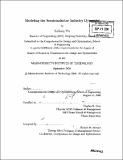| dc.contributor.advisor | Charles H. Fine. | en_US |
| dc.contributor.author | Wu, Kailiang | en_US |
| dc.contributor.other | Massachusetts Institute of Technology. Computation for Design and Optimization Program. | en_US |
| dc.date.accessioned | 2009-04-29T17:19:55Z | |
| dc.date.available | 2009-04-29T17:19:55Z | |
| dc.date.copyright | 2008 | en_US |
| dc.date.issued | 2008 | en_US |
| dc.identifier.uri | http://hdl.handle.net/1721.1/45280 | |
| dc.description | Thesis (S.M.)--Massachusetts Institute of Technology, Computation for Design and Optimization Program, 2008. | en_US |
| dc.description | Includes bibliographical references (p. 89-92). | en_US |
| dc.description.abstract | The semiconductor industry is an exciting and challenging industry. Strong demand at the application end, plus the high capital intensity and rapid technological innovation in manufacturing, makes it difficult to manage supply chain planning and investment in technology transitions. Better understanding the essence of the industry dynamics will help firms win competitive advantages in this turbulent market. In this thesis, we will study semiconductor industry dynamics from three different angles: quantitative modeling, industry dynamics simulation, and strategic analysis. First, we develop a stochastic linear optimization model to address the supplier's "order fulfillment dilemma" suggested by previous empirical studies. The model provides optimal equipment production decisions that minimize the total cost under stochastic demand. To solve the large scale problem, we introduce the Bender's Decomposition, which is proven to outperform the pure Simplex method. Furthermore, we extend the basic model to multiple periods, allowing equipment inventory planning over a period of time. Second, we build a macro-level industry dynamic model using the methodology of System Dynamics. The model includes components of electronics demand projection, fabrication capacity allocation, fabrication cost structure, technology roadmapping as well as equipment production and R&D. The model generates projections of demand , industry productivity, schedule of building new fabrication, adoption of the latest process technology, etc., which are validated by actual industry data. In addition, we devise a control panel in the software that enables the users to implement flexible scenario and sensitivity analysis. Third, we propose a strategic framework for companies to pinpoint the root causes of the supply-demand mismatch problem. | en_US |
| dc.description.abstract | (cont.) This framework considers long lead times, fast clockspeeds, Moore's Law, and risky product and technology, which transitions contribute to the pronounced volatility amplification occurring in the semiconductor industry. This framework, along with several industry successful practices, will assist companies to mitigate the demand volatility and improve their supply chain performance. | en_US |
| dc.description.statementofresponsibility | by Kailiang Wu. | en_US |
| dc.format.extent | 92 p. | en_US |
| dc.language.iso | eng | en_US |
| dc.publisher | Massachusetts Institute of Technology | en_US |
| dc.rights | M.I.T. theses are protected by
copyright. They may be viewed from this source for any purpose, but
reproduction or distribution in any format is prohibited without written
permission. See provided URL for inquiries about permission. | en_US |
| dc.rights.uri | http://dspace.mit.edu/handle/1721.1/7582 | en_US |
| dc.subject | Computation for Design and Optimization Program. | en_US |
| dc.title | Modeling the semiconductor industry dynamics | en_US |
| dc.type | Thesis | en_US |
| dc.description.degree | S.M. | en_US |
| dc.contributor.department | Massachusetts Institute of Technology. Computation for Design and Optimization Program | |
| dc.identifier.oclc | 311815389 | en_US |
